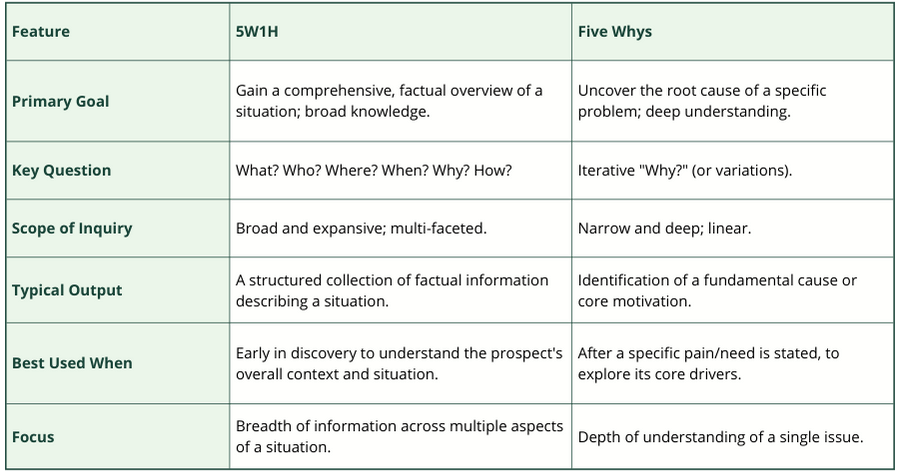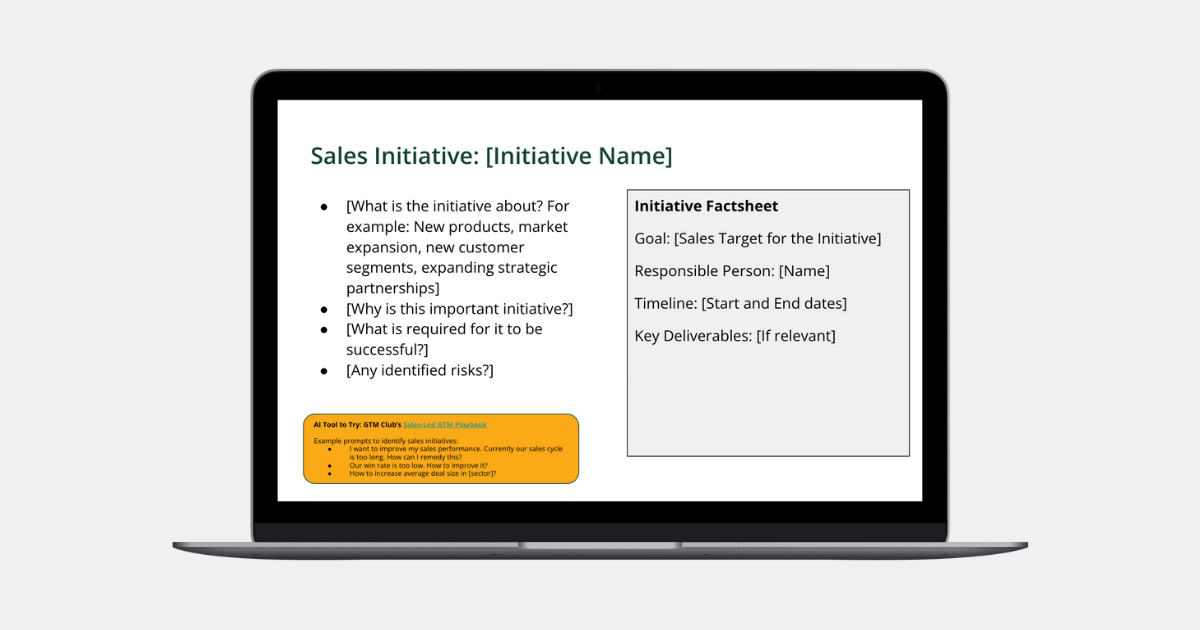Winning Through Discovery Ws
Sales is about winning. This article gives you the Ws (What, Who, Where, When, and Why) to win more and bigger opportunities through questioning techniques, 5W1H and Five Whys.

Discovery aims to understand the underlying reasons for a prospect's interest and need in a product or service. Understanding the prospect's situation well is essential, as it informs and shapes every subsequent step in the sales process, allowing for a personalised rather than a generic approach.
When doing discovery, sales should ask open-ended questions. Especially when trying to pierce through surface level to get to the actual pains and motivations driving the prospective customer. Through open-ended questions, sellers should identify operational inefficiencies, strategic hurdles, unfulfilled objectives, or frustrations that their product or service is designed to alleviate.
While they are not “sales-only” frameworks, we provide account executives with two questioning techniques to help them conduct discovery and dig deep into their prospects' businesses: 5W1H and Five Whys.
5W1H in Tech Sales
The primary goal for 5W1H is to provide a broad, comprehensive overview of a situation or problem by asking questions across multiple dimensions. In a nutshell, 5W1H is used to get the big picture.
What is 5W1H?
The 5W1H questioning technique is an acronym representing six fundamental questions: What, Who, Where, When, Why, and How.
5W1H is a questioning technique employed to comprehensively understand a situation or problem by analysing all its key aspects from various perspectives. This technique, sometimes called the Kipling Method (after Rudyard Kipling's poem "I Keep Six Honest Serving-Men"), aims to gather all the essential elements required for a complete assessment. Its purpose is to explore all dimensions of an issue so that no critical information is overlooked.
When to Use 5W1H in Discovery?
The 5W1H questioning technique is most effective at the beginning of your discovery process, particularly during initial calls when you need to quickly understand the broader context of your prospect's business situation. It helps you gather comprehensive information about the business landscape, key players, and general challenges before going into specifics.
The 5W1H technique is most effective during initial calls and meetings.
This questioning technique is an excellent precursor to more focused techniques like Five Whys. By mapping the overall situation, you can identify the most critical areas that warrant deeper investigation. Whether scoping out a pain or preparing for a solution presentation, 5W1H ensures you understand the complete picture rather than just individual aspects of your prospect's situation.
How to Use 5W1H In Discovery?
A salesperson can use 5W1H to get the big picture reasonably quickly. Here is an example set of questions to cover with a prospect, in a form suitable for the conversations.
- What is a pain or problem they are currently struggling with?
- Where in their business do problems and pains occur?
- Who are the key people impacted and involved?
- When do these challenges typically arise or become most acute?
- Why are these issues or challenges happening?
- How are they currently attempting to manage or mitigate these issues?
Check out an example where a salesperson asks a prospect Level Two discovery questions using 5Wh1.
In the post above, Keith Weightman tells you how to use the 5W1H method in just over a minute.
Five Whys in Tech Sales
The Five Whys' purpose is to drill down iteratively to find the root cause of a specific, already identified problem or to understand the deep underlying motivations behind a business goal. While 5W1H provides the big picture, 5 Whys zooms in. The devil is in the details.
What is Five Whys
The Five Whys technique is an iterative, interrogative method designed to explore the underlying cause-and-effect relationships of a particular problem. It is a systematic questioning process that peels off superficial layers to reveal the root cause. Initially developed in the 1930s by Sakichi Toyoda, founder of Toyota Motor Corporation, the technique was built on his principle that "by repeating 'why' five times, the nature of the problem as well as its solution becomes clear."
While the Five Whys technique is predominantly known for problem analysis, its application extends to understanding the reasons behind a positive outcome or the motivations for pursuing a specific goal. This versatility is particularly relevant in sales, where conversations often involve helping prospects achieve their objectives, fix existing problems, or capitalise on emerging opportunities.
When to Use Five Whys in Discovery?
The Five Whys technique works best when a seller and prospect have already identified a specific problem, pain point, or goal to focus on. At this point, the salesperson can use Five Whys to understand the fundamental drivers and tailor a relevant solution.
The Five Whys technique works best when salesperson has identified a specific problem, pain point, or goal to focus on.
Five Whys offers a simple yet powerful framework for B2B technology and SaaS sales professionals. It helps them move beyond surface-level discussions to uncover the genuine root causes of a prospect's challenges, needs, or goals. When applied skillfully, this iterative questioning process transforms sales discovery from a feature-matching exercise into a deeper, more consultative engagement.
How to Use Five Whys in Discovery?
The Five Whys technique is not about mechanical questioning but a thoughtful approach to understanding deeper motivations. It is particularly valuable when illuminating an initially vague or surface-level problem. For example, if a prospect wants to simply "improve efficiency," the Five Whys can dissect this: Why do you need to improve efficiency? Why is current efficiency a concern? And so on until a specific, actionable root cause is identified.
Successfully employing the Five Whys in sales discovery relies on a conversational and empathetic approach, not a rigid, interrogative one. When asking questions during discovery, framing them conversationally is necessary rather than using direct, stark questioning. Instead of simply asking "Why?", use more nuanced approaches like "What's driving this priority?" or "Help me understand the importance to your team." The key is maintaining a natural, supportive dialogue where questions flow organically. And, regardless of the name, there is no need to force "Why" in every question.
Approaching discovery as described requires active listening and validation of the prospect's challenges. Pay close attention to each response, as it guides your next question, and remember to acknowledge their pain points to build rapport and demonstrate understanding.
Salesperson (Why 1): "You mentioned your team consistently misses delivery deadlines. That sounds like a significant challenge. To help me understand better, could you share why your team is missing these deadlines?"
Prospect (surface-level cause): "Our route planning software is outdated. Our drivers often encounter unexpected traffic or inefficient routes the system can't handle."
Salesperson (Why 2): "I see how outdated software could cause those issues. Why does the current system struggle with efficient routes and real-time updates?"
Prospect (technical limitations): "It's an older system using manually updated maps, with no real-time GPS integration or dynamic rerouting. We bought it years ago, and it hasn't kept pace with our needs."
Salesperson (Why 3): "Given these limitations affecting deliveries, why has the company continued using this outdated system?"
Prospect (organisational factors): "It's mainly a budget issue. New software is a big investment. Plus, senior management is worried about disruption and training time for a new system."
Salesperson (Why 4): "That's understandable. Why has it been hard to secure budget approval or address these concerns, considering the impact on deliveries?"
Prospect (lack of data): "While we know late deliveries are a problem, we can't quantify their financial impact. I mean things like lost customer goodwill, penalties, wasted fuel, and driver overtime. Without concrete numbers, we can't make a compelling case against other priorities."
Salesperson (Why 5): "That's insightful. Why hasn't the team been able to quantify these impacts?"
Prospect (Root Cause): "We lack the tools and expertise to gather and analyse this data. Our systems don't show the cost drivers of inefficient routing, and we don't have an analyst who could model the ROI of a new system."
Outcome: The SaaS salesperson now has a much richer understanding. The initial problem of missing delivery deadlines, caused by outdated software, has been traced back to a root cause: a lack of data visibility and analytical capability to justify investments in operational improvements.
Bonus: Five Ready-to-Use Variants of “Why?” for Your Next Discovery Call
- “What’s driving this as a priority right now?”
- “How have you managed without solving this until now?”
- “What's prompted this issue to escalate internally?”
- “What would success look like if you solved this problem?”
- “What’s prevented tackling this effectively in the past?”
Winning With Ws
The two frameworks are not mutually exclusive and can be highly complementary. The 5W1H method can effectively set the stage for a Five Whys analysis. The broad information gathered through 5W1H can help identify the most critical problem area or the most relevant initial "Why" that becomes the starting point for a deeper Five Whys investigation. Combining these techniques allows for breadth and depth in analysing prospects' needs.

For B2B tech and SaaS sales teams, integrating the Five Whys or 5W1H into their discovery toolkit can lead to more accurate discovery, stronger value propositions, and solutions that better match their clients' needs. Achieving this requires understanding the technique and investing in the training and coaching to ensure salespeople can wield them effectively. The ultimate goal is to foster a sales approach prioritising understanding and genuine problem-solving.




